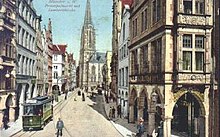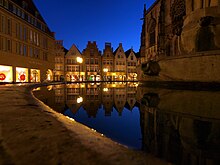Principal market
The Prinzipalmarkt is a street in Münster, Westphalia . The name means main market , in contrast to the rye market and fish market , which follow the street. The Prinzipalmarkt documents the historical and structural development of the economic and political center of Münster with its floor plan and buildings. As a monument area , the Prinzipalmarkt enjoys comprehensive ensemble protection. It is also known as the “parlor” of Münster.
Appearance
The appearance of the Prinzipalmarkt development is characterized on both sides by a row of gabled houses. The only interruption is Michaelisplatz, the breakthrough to Domplatz . A special feature of the Prinzipalmarkt is that no two gables are alike. Some of the architects of the time took ideas from the other gables, but everyone implemented their own ideas and thus gave the Prinzipalmarkt its shape. The square is closed on the north side by the tower of the Lambertikirche , on the south side by the town house tower .
The main design elements of the Prinzipalmarkt are the Baumberger sandstone , typical of Münster, used for the facade design and the arcade on the ground floor of the houses on the east and west side of the Prinzipalmarkt. The most famous building on Marktstrasse is the historic town hall . This is followed by the Stadtweinhaus and the Prinzipalmarkt 5 office building .
In 2006, the Prinzipalmarkt reached fourth place in the ZDF program Our Best - The Germans' Favorite Places .
story
The development as a bourgeois market street on the edge of the cathedral freedom and on the eastern cathedral castle border began in the 12th century. There was probably a closed development around 1280. At the turn of the 13th to the 14th century, the archway that characterizes the Prinzipalmarkt was built. With a few exceptions, the structure of the parcels and the number of buildings have largely been preserved from around 1500 until today. It wasn't until the beginning of the 17th century that the name Prinzipalmarkt came up.
During the Second World War , most of the buildings on the Prinzipalmarkt were completely destroyed , some except for the basement and the first floor arbor. Due to the reconstruction that took place between 1947 and 1958, the Prinzipalmarkt was able to maintain its character as an ensemble in the form of a historical market location. Although many buildings have been changed significantly compared to the pre-war state, the reconstruction was carried out on the old parcels and using the original materials and design elements.
Trams ran on Prinzipalmarkt until November 25, 1954 .
- Heritage nominations
After the city of Münster sought to obtain UNESCO World Heritage status for the town hall in 2002 and in summer 2011, the declaration of interest for inclusion in the list of world cultural heritage, which is to be updated in 2015, was announced in autumn 2011. At the beginning of July 2012 it became known that the desired appointment could not be achieved again.
Therefore, an attempt was subsequently started to achieve recognition of the city center as a European cultural heritage . The old town arch from the Rothenburg to the Spiekerhof is to be nominated , which stands for a compromise between historical reconstruction and new planning based on history. In addition, the Lambertikirche was proposed as one of 19 "Reformation sites" by the Conference of Ministers of Education for the award. On April 15, 2015, the historic town hall, together with that of Osnabrück, was awarded the European Heritage Seal by the European Commission as one of the sites of the Peace of Westphalia .
Shopping mile
Since the 15th century, mainly shopkeepers and merchants have lived on the Prinzipalmarkt. Many offers of the local retail trade are mainly located on the Prinzipalmarkt in the historic merchants' houses.
With the construction of the Münster Arkaden shopping center between 2004 and 2006 not far from the Prinzipalmarkt, many merchants feared a lack of customers. However, the arcades were kept quite small and some of the local shops were given to merchants from Münster. This was to prevent Münster from experiencing the same fate as Oberhausen through the CentrO or Hamm through the Allee Center , namely the “extinction” of the historic old town.
With over 5500 passers-by an hour on a Saturday, the Prinzipalmarkt was the second busiest shopping street in Münster after Ludgeristraße in May 2011. However, after the new shopping complex on Stubengasse opened in 2010, pedestrian frequency on the Prinzipalmarkt has fallen by a third compared to 2008.
Geographical information
The Prinzipalmarkt is the center of the town as defined by the RWB . It is the zero point or the beginning of the mileage count of the federal and country roads going through Münster.
The middle of the lane of the Prinzipalmarkt in front of the town hall is 60 m above sea level.
Trivia
During the Bicycle Days 1990, a photo session was created on the Prinzipalmarkt under the leadership of the city planning office, showing the amount of space used in traffic.
In 2017, a painting was exhibited on the Krippenweg in the Handorf district of Münster , in which the Christmassy birth of Jesus takes place at the Prinzipalmarkt.
literature
- Roswitha Rosinski: Dealing with history when rebuilding the Prinzipalmarkt in Münster / Westf. after the 2nd World War. (= Monument Preservation and Research in Westphalia , Volume 12.) Habelt, Bonn 1987, ISBN 3-7749-2230-6 .
- Karl-Heinz Kirchhoff: The Prinzipalmarkt with Michaelisplatz, Gruetgasse, Syndikatgasse and Syndikatplatz. Aschendorff, Münster 2001, ISBN 3-402-06643-2 .
Web links
- Principal Market website
- Marlies Voss: Continuing construction in 1945 - The reconstruction of the Prinzipalmarkt. (PDF) In: muenster.de. January 31, 2013, accessed on January 3, 2016 (series of lectures by the municipal monument authority in the Dominican Church on the occasion of the exhibition of the German Foundation for Monument Protection in Münster “See what a precious heritage”).
- Panorama photos from the Prinzipalmarkt
- 360 ° panoramic image of the Prinzipalmarkt in the Westphalian Cultural Atlas (requires Flash player )
Individual evidence
- ↑ According to Section 2, Paragraph 3 of the Monument Protection Act of North Rhine-Westphalia of March 11, 1980, monument areas are “majorities of structures, even if not every associated individual structure meets the requirements of Paragraph 1. Monument areas can be city plans, cityscapes, townscapes and silhouettes, city districts and districts, settlements, groups of farmsteads, streets, overall structures and individual buildings as well as their immediate surroundings, provided that it is important for their appearance. "
- ↑ Monument Area Statute Prinzipalmarkt Münster. In: Official Journal of the City of Münster 1997. October 14, 1997, p. 131 , accessed on September 20, 2019 . in the version of Article 8 of the statutes for the adaptation of local regulations to the euro of September 21, 2001 (Official Gazette of the City of Münster 2001 p. 122)
- ↑ Wolfgang Schemann: UNESCO list: Münster's town hall is to become a world cultural heritage. In: Westfälische Nachrichten . June 11, 2011, accessed September 20, 2019 .
- ↑ Klaus Baumeiste: Criticism of the Greens: Register the Prinzipalmarkt as a world cultural heritage. In: Westfälische Nachrichten. October 11, 2011, accessed September 20, 2019 .
- ↑ Klaus Baumeister: NRW state government favors the "Ruhr area cultural landscape": Prinzipalmarkt not on the list for world cultural heritage. In: Westfälische Nachrichten. July 1, 2012, accessed September 20, 2019 .
- ↑ EU seal: the inner city is now to be “European cultural heritage”. In: Münstersche Zeitung , July 3, 2012
- ^ A b Martin Kalitschke: Application for a cultural heritage seal: Now Munster is trying it with the EU. In: Westfälische Nachrichten. July 4, 2012, accessed September 20, 2019 .
- ↑ Sebastian Stricker: Site of the Peace of Westphalia - Osnabrück City Hall becomes a European cultural heritage. In: noz.de. Retrieved September 20, 2019 .
- ↑ Klaus Baumeister: Customer frequency: Ludgeristraße is the busiest shopping street - Prinzipalmarkt is losing. In: Westfälische Nachrichten. June 4, 2011, accessed September 20, 2019 .
- ↑ a b Annual Statistics 2018 of the City of Münster. (PDF; 408.14 kB) In: stadt-muenster.de. Office for Urban Development, Urban Planning, Transport Planning of the City of Münster, February 21, 2019, p. 3 , accessed on September 20, 2019 .
- ↑ just think about it. (PDF; 4,307.4 kB) In: stadt-muenster.de. Office for Urban Development, Urban Planning, Transport Planning of the City of Münster, accessed on September 20, 2019 .
Coordinates: 51 ° 57 ′ 44 " N , 7 ° 37 ′ 41" E









